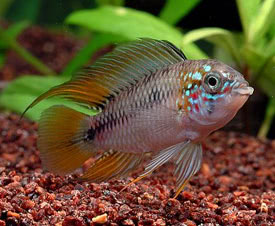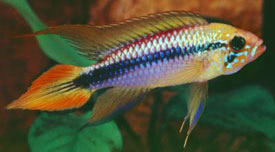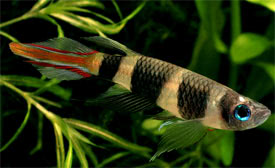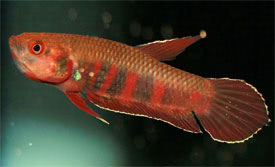
 Magyarul / Hungarian
Magyarul / Hungarian


- Scientific name: Apistogramma borelli
- Common name: Yellow dwarf cichlid, Borelli's dwarf cichlid
- Synonyms: Heterogramma borelli, Apistogramma ritense, A. reitzigi, A. aequipinnis, A. rondoni
- Group: Cichlids
- Habitat: South America; Matto Grosso and rivers near Rio Paraguay.
- Size: Male: 7 cm, female: 5 cm
- Biotope: It occurs in creeks and tributaries of both the Rio Paraguay and lower Rio Paraná basins.
- Social behavior: A territorial, peaceful cichlid, it rarely burrows.
- Diet: Carnivorous; all types of live food, rarely accepts flakes.
- Breeding: Quite hard
- Tank: Minimum 55 litres
- Population: 1 male and 2 females for 80 litres
- Decoration: Needs a tank with dense vegetation and places to hide among rocks and roots. Recommend a dark tank bottom, possibly lavalit, with clear, nitrate-free water. Frequent water changes are suggested, with a good water conditioner added.
- Temperature: 22-26 °C
- pH: 5-7.
- Hardness: 1-10 NK°
- Lifespan: 3-5 years
Description: A laterally compressed cichlid that has a stockier, less elongated body than Apistogramma agassizi. The head and the area just behind the gill cover are golden-yellow. The belly and the very top of the back may also be golden-yellow in color. The middle area of the body is pale blue as are the dorsal, pelvic, and front parts of the anal fins. The dorsal and pelvic fins are gold-tipped. The caudal fin and most of the anal fin is golden-yellow. A short, black stripe extend through the eye and to the snout. The Apistogramma borelli is sensitive to water conditions and medication.
Sexual dimorphism: male is larger and more brilliantly colored with sharply pointed dorsal and anal fins. The Apistogramma borelli is polygamous, so one should keep several females with a single male. The male claims the upper tank areas, while the females utilize the lower. Forms a patriarch/matriarch family.
For breeding use moderately acid, soft to medium-hard water (ph 6-6,5 and hardness 2-15 °dGh) at a temperature between 25-28 °C. A cave breeder, the female will lay 50-70 eggs against the roof of her cave. A female may not labor over the eggs, but she will carefully guard the fry, leading them around the tank. Once the fry are free swimming, they can be fed on newly hatched brine shrimp.









































































